Private Owner
Wagon and Van Design
As the canal system had evolved in the 18th century the
authorities became concerned about the development of monopolies.
They decided that canal companies should not operate their own fleets
of barges but instead they would operate rather like toll roads,
where the canal company provided the route and charged people for
using it. Hence the 'private owner' barge was the norm on the canal,
which had the additional benefit for the canal company of using the
capital of the private owners to build the barges rather than the
canal company's money.
The system worked well enough on
canals and in the early days of the horse hauled railways everyone
thought they could work in the same way. The Stockton &
Darlington Railway used several private sub-contractors for hauling
both goods and passenger trains. When the Liverpool & Manchester
act was in parliament it was stipulated that private owners could
build lines joining to the main line and operate their own rolling
stock. The widespread introduction of steam locomotives and the
increasing density of traffic on the steam hauled railways made the
'toll road' system unsafe. The 1845 Railway Clauses Act retained the
rights of private owners to operate their own wagons but required all
trains to be hauled by a railway company locomotive.
In the
early years privately owned vehicles were mainly chauldron type
mineral wagons (see Goods Rolling Stock Design - Introduction). These
were usually unpainted wood with the owners name painted crudely on
the side. It was only in the 1860's that more colourful flat-sided
open wagons with the merchants name on the side began to appear. The
mineral wagon dominated the private owner side of the business and
these are considered in detail below. Note that open wagons marked
with the name of a firms product, such as Izal disinfectant or
Cadbury Chocolate, would probably not be for carrying the product but
would be mineral wagons used to supply coal to the factory.
Dumb
buffers were common on private owner stock up to the early years of
the twentieth century. They can be modelled by trimming down the
buffers on a commercial model chassis and building them up with
Milliput. Most early wagons had a hand brake on only one side, often
acting on only one wheel. This difficult to model using a standard
ready-to-run chassis but I have made a few by trimming away the V
hanger and brake handle on a Peco chassis and adding a new brake
handle from 10x20 thou strip. See 'Goods Rolling Stock
Design-Chassis-Buffers' and 'Goods Rolling Stock Design-Chassis-
Brakes' for further information.
The Railway Clearing
House (RCH), originally set up by the railway companies to handle
charges for vehicles wandering onto another company's line,
introduced standard minimum specifications for private owner wagons.
The first significant RCH specification for private owner wagons was
published in 1887 and the Railway companies supported this move by
refusing to accept non RCH standard wagons in their trains. The
second full RCH specification was issued in 1909 and it was this
which required the elimination of dumb buffers (with a time limit set
at 1914 for modification or withdrawal of non-standard wagons). There
were various amendments added to these specifications and the
situation was further complicated by fluctuations in the economy and
various wars. The RCH standards took many years to be implemented and
in the event dumb buffers lasted rather longer than planned.
Not
all 'private owner' wagons were owned by the firm whose name was
painted on the side, the railway companies and the wagon builders all
offered leased vehicles as an option for the less wealthy operators.
Leased railway company rolling stock might be painted with the livery
of the hiring company, although a simple marking 'To be returned to.
. . .' was more common. In the case of seasonal traffic (for example
blankets being shipped to shops ready for the winter) railway company
stock would be used but this might have name boards, or just painted
tarpaulin signs, attached to some or all of the vans.
There
were advantages to owning or leasing your own wagons, for one thing
if your wagon was delayed loading or unloading somewhere you did not
have to pay the railway company for it's hire. The payment made for
retaining a wagon in this way is called 'demurrage'. Some private
owner wagons and more particularly vans stayed in the same place for
a very long time, in effect being used as a temporary store or
warehouse.
The legislation which defined the railways as
'common carriers' allowed the railway companies to refuse to carry
cargo in its own wagons which might cause damage to the wagon or to
other cargo. A good example of this would be lime. In addition some
commodities might be tainted by carriage with more general cargo, one
example of this being salt. There were therefore quite a number of
specialised vehicles built for the carriage of materials such as lime
and salt. These two commodities both had to be kept dry so wagons
used for this traffic often had house-type peaked roofs (called
'cottage tops' by railway men). Both Peco and Graham Farish offer
roofed wagons suitable for these trades. It should be noted that some
lime and salt wagons did not have a solid roof but instead had raised
ends to support a tarpaulin. The ends could be rounded or pointed but
the latter usually also sported a wooden rail to support the
tarpaulin.
Tar coated stone chippings for road surfacing was
moved in some quantities in the 1920's and early 1930's but this
traffic generally transferred to the roads by 1940. Railway wagons
used for this were all privately owned vehicles with low sides,
typically three planks high or with similar sized iron bodies. The
wooden tarred chippings wagons had steel sheeting added to the floor
to protect the wood from the tar and there would be silvery or rust
coloured streaks visible on the floor after unloading.
Up to
the First World War iron and steel companies operated a number of
privately owned wagons for carrying ingots, forgings and even sheet
and rod. The railways were happy to build stock for this work as the
traffic was regular and profitable so these private owner iron and
steel wagons had largely disappeared by the time of the First World
War.
The private owner vans were rather rare but were often
of interesting non standard designs featuring lower than normal roofs
or even 'peaked' roofs. The main problem with modelling these vans is
that many of the early examples had complex external framing, making
lettering difficult. Up to the 1930's quite a number of outside
framed vans were operated by the South Wales tin-plate companies and
modelling one of these vans, with one suggestion for lettering the
model, has been included in the section on Livery Modification. The
cement companies owned quite a number of the GWR type iron bodied
vans, usually painted in rather complex liveries. They also owned a
number of wooden vehicles as well and some early examples had the
relatively simple BPCM livery. The British Portland Cement
Manufacturers and other cement distributors such as Blue Circle are
discussed in detail in Volume 2 under Cement.
In Scotland
there were several fleets of small (ten or nine foot wheelbase) grain
hopper wagons, two are preserved at the Bo'ness and Kinniel Steam
Railway and one of these forms the basis for a Parkside Dundas
(formerly Westykits) 'OO' kit. Modelling these wagons is discussed in
the section on 'Kit Bashing'.
Fig ___ Unusual Private Owner wagons
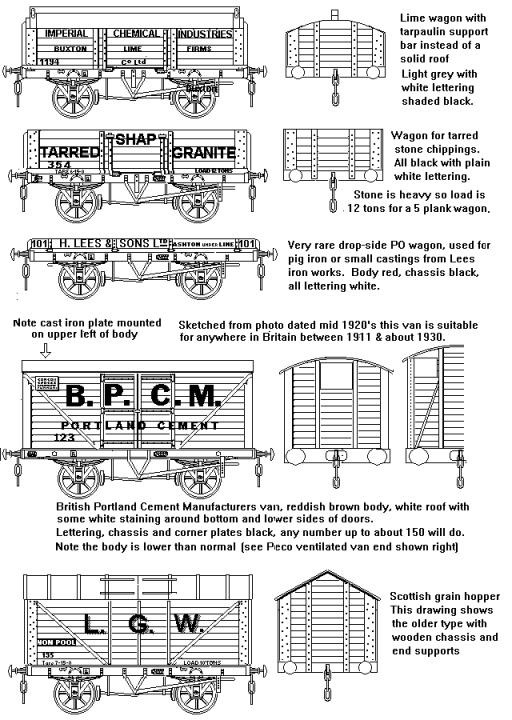
Fig ___ Models of a cement van and Scottish grain
hopper

Private Owner Mineral Wagons
It is
in the nature of the British railway system that mineral wagons, used
for coal, stone or metal ores, have always outnumbered other wagons
in use. Of these the most common has always been the coal wagon,
millions of which were built.
The early coal wagons were of
the chauldron type, a hopper shaped body with spoked wheels and inside
bearings (see Goods Rolling Stock Design - Introduction for a sketch
of one of these wagons). By the 1840's square bodied wooden mineral
wagons were becoming more common although it was not until the 1860's
that these became the accepted standard. At this time the sides of
coal wagons were generally only four planks high and a typical load
was eight tons. Heavy outside frames of timber were still commonly
being used for the wagon bodies but metal reinforcing had started to
appear. The Morton brake appeared in the 1880's and soon became a
common standard for private owner wagons, early examples retained the
large brake blocks as shown in the sketch below.
Fig ___
Early Private Owner Mineral Wagons
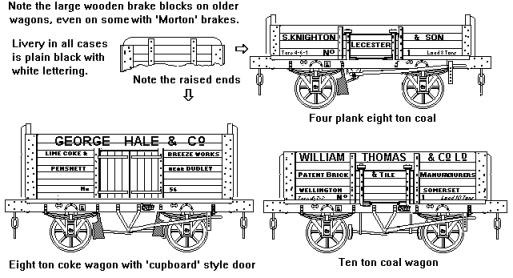
Modelling these wagons was described in Railway Modeller July
2001 (Traffic for Tickling Article 4)
By the turn of the
century coal wagons were built with sides of seven or even eight
planks, capable of carrying a load of up to 12 tons. These were still
outnumbered by the smaller four and five plank wagons which had a
capacity of perhaps eight tons each. Collieries and larger concerns
favoured the larger wagons, local traders preferred the smaller
vehicles. Prior to the First World War it was not uncommon to see
raised ends on private owner coal wagons. The owners would try and
rent their vehicles out for other traffic during the summer months
and the raised ends were provided to support a tarpaulin. By the
later 1920's very few private owner mineral wagons were built with
raised ends, reflecting their abandonment on general goods wagons by
the larger railway companies.
On mineral wagons the top one
or two planks were usually continuous above the drop-down side doors.
Generally the five plank coal wagons had both ends fixed but some of
these and many of the 7 or 8 plank wagons might have one or both ends
fitted with a door hinged along the top edge. In Scotland some wagon
builders favoured cupboard style double doors in the sides and
vertically planked end doors, with heavy timber external frames, the
LNER inherited quite a number of this kind of wagon from the
pre-grouping companies. The end door was hung from a timber beam
rather than a metal rod, supported by metal hoops attached to the
framing on the door itself. These can be produced from the Peco five
plank wagon with a bit of carving, but they were rarely seen south of
the border.
Fig ___ Scottish designed wagon with cupboard
style side doors and vertically planked iron hooped end door
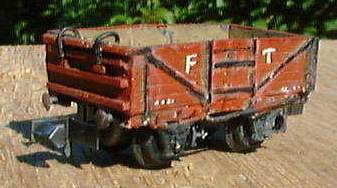
Modelling
these wagons was discussed in Railway Modeller July 2001 (Traffic for
Tickling Article 4), the livery shown is for a fictional light railway
Elsewhere drop-down side doors and
horizontal planked end doors with metal strips were the norm. Wagons
with end doors could be emptied by tipping them up but the method of
tipping these 'end door' wagons depended upon the location. In some
cases this involved a hinged section of track or the wagon might be
emptied into a barge or ship by lifting it bodily with a crane or
hoist. The maximum angle a wagon could be tipped was about forty five
degrees, any more than this put unusual loading on the axle bearings
(see Volume 2 Fig ___).
The end fitted with the door was on
railway company stock usually indicated in some way. The Midland
Railway and in the early years is successor the LMS used a white
vertical stripe on the wagon side at the end with the door. By the
late 1920's by a diagonal white stripe on the side became the norm
for all companies although the size and location of the stripe varied
somewhat. Some wagons were built with only an end door and no side
doors, some of these wagons had end doors at both ends. These were
used for supplying larger consumers such as electricity generating
stations or for the docks in South Wales, where wagon tipping
facilities were the standard method of emptying the wagons.
Fig
___ Ex Private Owner end-door only steel wagons in British Railways
livery
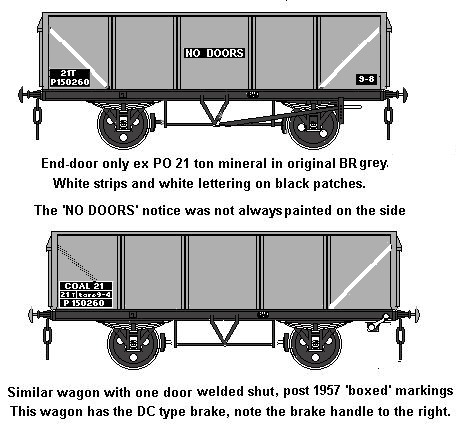
Mineral wagons also often had bottom doors, to allow the
load to be emptied through the bottom. Bottom doors were usually
indicated by a shallow open V symbol, something on the lines of \ /
painted near the bottom on the side of the wagon. Details of all such
markings are considered separately under Liveries. If the wagon's
side door was damaged these bottom doors could be used to empty the
load onto the track underneath, the coal then being shovelled out by
hand.
Private owner coal wagons presented several problems
for the railways. By the nature of the trade half the wagons would be
empties being returned to collieries and because of the government
regulations on charging these brought in very little revenue. Their
low capacity meant they occupied a disproportionate amount of siding
space and they were often poorly maintained and many of the private
owner wagons were old and poorly maintained. The grease filled axle
box was virtually standard on privately owned rolling stock but these
grease boxes tended to dry out, causing fires and sometimes melting
the ends off the axles. Wagons of this type had to have their axle
boxes inspected frequently when in transit. There were various
attempts to rationalise this situation, the Midland Railway made a
serious attempt to buy up all the private owner rolling stock on its
lines, but they found they couldn't afford the exercise.
From
the 1880's various experiments were made with higher capacity mineral
wagons, mainly by the railway companies themselves. The Caledonian
Railway up in Scotland built some large bogie coal wagons at about
this time.
Only the railways of the North East made extensive
use of hopper wagons for coal although they had to provide coal drops
or ramped discharging bays for hoppers in their goods yards. The
North Eastern Railway actively discouraged private owner coal wagons,
offering instead a range of four wheeled wooden bodied hoppers of up
to twenty ton capacity for lease to coal traders at preferential
rates. There were some private owners who still preferred to operate
their own wagons even under this regime and they built hopper wagons
of a broadly similar design (see Fig ___). Other companies tried
similar schemes and the GWR followed the example of the North Eastern
by building rolling stock itself and offering preferential rates for
people leasing these wagons. They built large numbers of 20 ton four
wheel wagons on a twelve foot wheelbase with oil axle boxes from
about 1900, these were iron bodied with curved corners and early
versions had no end doors. The same basic design was developed,
adding square corners in about 1918 and they were built with doors at
one or both ends and either one or two doors on either side. The 20
ton wagons required something like a third less siding space for a
given quantity of coal and they had fewer axles for a given load, so
a loco could pull a larger payload. The drawbacks were the poor
quality of many colliery lines, restricting the maximum axle loading,
and the cost. In 1923 the GWR's Felix Pole introduced a thousand 20
ton end-door wagons to be leased or sold on hire-purchase to the
larger private owners.
Fig ___ Felix Pole 20 ton coal
wagons
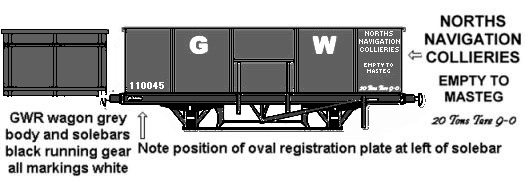
By the early twentieth century there were about half a
million private owner coal wagons on the system, typically of seven
to ten tons capacity and usually fitted with grease-filled axle
boxes. In 1920 the Railway Company Association suggested a standard
for a seven plank coal wagon of 12 tons capacity with a 10 foot wheel
base which formed the basis for the Railway Clearing House standard
specification of 1923, but the older wagons continued in use for many
years.
Fig ___ RCH 1923 Standard Coal Wagon
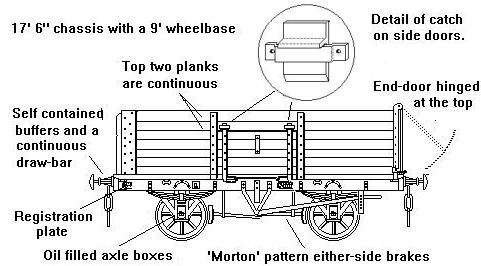
Converting a Peco mineral wagon to an end door type was
described in Railway Modeller March 2001 (Traffic for Tickling
Article 2)
Coal exports stopped during the First World War
and many of these trades never resumed. With the General Strike of
1926 and the general depression in the 1920's and 1930's domestic
demand for coal slumped and investment was scarce. In spite of this
more of the 'Felix Pole' wagons were built using the government low
interest loan scheme in the 1930's and by the outbreak of the Second
World War there were over five thousand GWR built twenty ton iron and
steel coal wagons on the system.
Smaller private owners in the
main stayed with the older wooden bodied stock, often retaining
grease filled axle boxes. The generally poor quality and capacity of
the private owner fleets was a matter of some concern from a safety
point of view and in 1919 the Ministry of Transport Act obtained
powers to restrict or prohibit the use of private owner wagons on
railway company lines. In the event these powers were never used,
mainly because of external economic factors such as the strikes of
the 1920's and the depression of the 1930's.
Not all private
owner mineral wagons were standard wooden bodied types, as well as
the various steel bodied wagons there were also hopper wagons in both
wood and steel but these were only operated by larger companies. Also
not all mineral wagons were for carrying coal, the iron and steel
industry built a number of mineral wagons for carrying ores, these
are low value cargo and hence of less interest to the railway
companies. The steel twenty ton hopper shown in Fig ___ was built in
1909 and was used for iron ore traffic.
Iron ore required low
sided wagons to keep the axle loading on a four wheeled wagon within
the permissible range, it was also moved in hopper wagons, fitted
with relatively small metal hopper bodies. The model shown in Fig ___
was built using a body from a Graham Farish open hopper wagon, full
details on modelling this wagon have been included in the section on
Kit Bashing (see Fig ___). These private owner ore hopper wagons were
never commonplace and would have operated on very restricted circuit
workings between the mine and the iron or steel works.
Fig
___ Unusual Private Owner Mineral Wagons
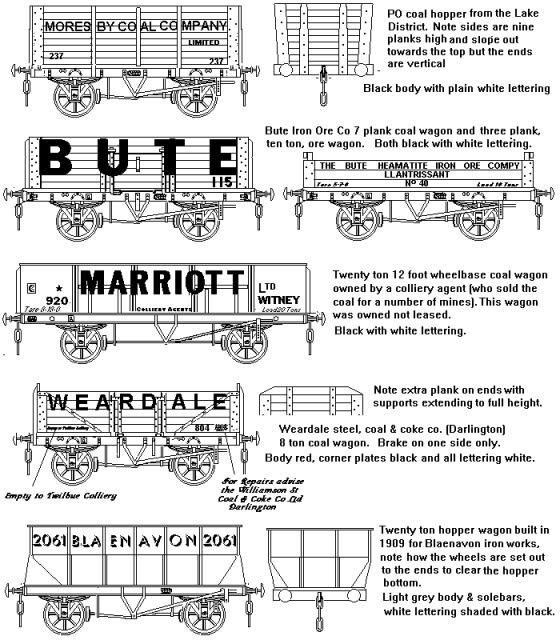
Stone, again a heavy and dense material, was moved in
low-sided wagons. Large blocks of stone were often carried on one
plank open wagons, dressed stone would travel in one or three plank
wagons and broken stone or 'road stone' usually travel led in three
or five plank wagons although this latter material was not a common
cargo prior to World War Two.
China clay, shipped as a thick,
wet, white sludge is also heavy and the areas in which china clay was
found there were some private owner 1, 2 or 3 plank open wagons built
for this traffic. These tended not to travel very far, running mainly
between production centres and river or canal wharves where the clay
was loaded into barges or small coastal sailing ships. The GWR, which
moved most of this traffic, built about a thousand special five plank
open wagons for this traffic in the late 1920's. Modelling the
china clay wagons was described in Railway Modeller May 2001 (Traffic
for Tickling Article 3. The conversion is simple, carve and scrape the supports from one end of the body, scribe in the planks acros the ends, add a rail of 20 thou rod across the top of the end and add three vertical straps (up the end and bent over the top of the rail) from 10x20 thou strip or strips of Bacofoil. You can also add three longitudinal strips of Bacofoil to the floor of the wagon, shiny side down, to represent the zinc sheets added to reduce rot from the wet clay.)
Fig___ GWR/BR china clay wagon model
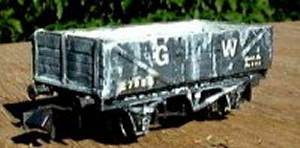
When
war broke out in 1939 well over ninety percent of the private owner
rolling stock consisted of coal wagons. During the war all these
private owner mineral wagons (not including specialised stock, such
as tar tanks, lime, salt and cement wagons) were requisitioned by the
Government and formed into a common pool. After the war British
Railways bought these mineral wagons from their previous owners,
paying compensation based on the capacity of the wagon and regardless
of condition (sixteen pound ten shillings for an 8-ton Private Owner
wagon). Some new private owner mineral wagons were built just after
the war but there were not many of these and with British Railways
policy of moving coal in its own wagons they had all been withdrawn
from service by the early 1960's.
In about 1952 the older,
low capacity wagons with grease axle boxes were all burned, a few of
the more modern wooden bodied wagons and many of the steel bodied ex
private owner wagons remained in British Railways service into the
1970's. There were many privately owned railways however, collieries,
docks and larger factories. These continued to use their own, often
elderly, rolling stock for many years and wooden bodied coal wagons
operated into the 1980's in docks and collieries.
Considering
the private owner wagons on offer the five plank wagons would mainly
have been private traders wagons. The seven plank mineral wagons were
favoured by collieries in the South Wales coal areas but the eight
plank type seems to have been more common in the Midlands and North
East coal fields. Minitrix offer an eight plank end door wagon, Lima
had a seven plank model (which looks better on a Peco ten foot
chassis) and P D Marsh offer a white metal kit of a seven plank end
door type. Peco have released a seven plank end door wagon as a kit
running on their nine foot wheelbase chassis and any layout set
before the 1970's should have a number of these. The Peco and Graham
Farish seven plank wagons have no end door, but the Peco five and
seven plank wagons can be modified to end door types. This was
described in Railway Modeller March 2001 (Traffic for Tickling
Article 2).
The Minitrix chassis used on their eight
plank and steel bodied coal wagons is of a 'fitted' type with clasp
brakes but virtually all private owner stock was unfitted so for
accuracy one should remove the outer brake shoes on the Minitrix
chassis. If you feel up to it you could try carving away the vacuum
cylinder as well, but that would be difficult. Alternatively you can
swop bodies with a Graham Farish single-vent van, which was more
likely to have such a brake. Most of the pre 1940 vans would not have
had the tie-rods between the wheels but some did have them and they
are tricky to remove neatly.
^
Go to top of page
International Good Guys ~ Making the world a better place since 1971 ~ Site maintained by

All material Copyright © Mike Smith 2003 unless otherwise credited








